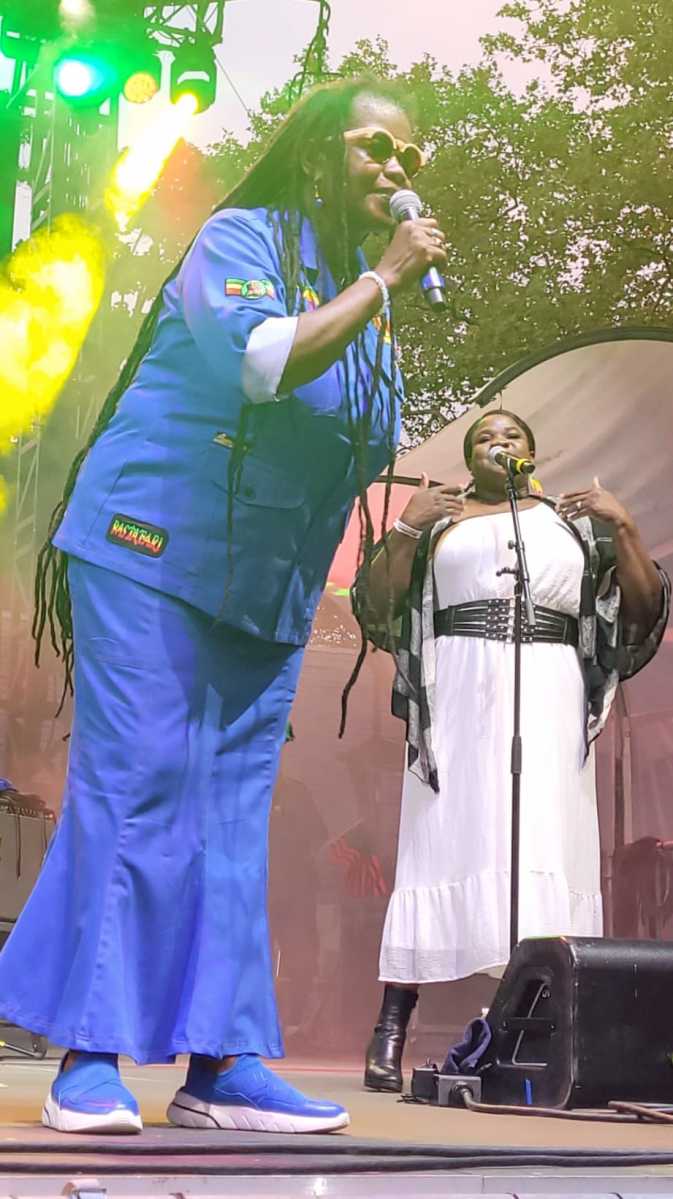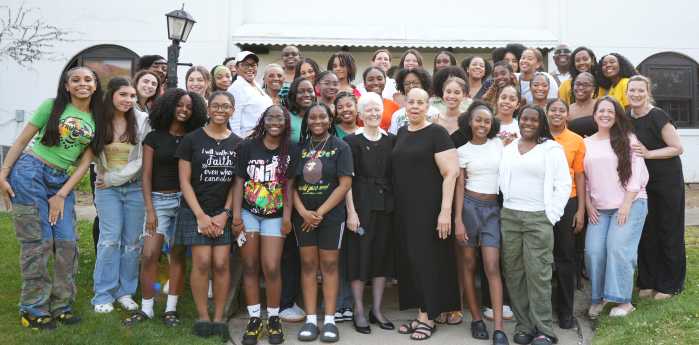Jamaican trailblazing deejay Sister Carol commands bragging rights for championing gender, Rastafarian doctrines, parenting, organic lifestyles, and a myriad of perceived socially ignored issues.
However, in 2025, her most persuasive endeavor was a brand collaboration with her daughter, Nakeeba Amaniyea.
On and off, the pair have been working on a compilation they recently launched in Brooklyn.
Titled “Beyond the Sky,” the production features 15 tracks that solidify each artist’s relationship in influencing music and culture.
Take the single about mother and child, “Muma & Pickney,” exemplifies a fusion of dancehall reggae with pop imprints from Simon and Garfunkel’s “Mother & Child Reunion” for a melange blended by expressive lyrical reggae, comprehension.
Versed in Jamaican patois stylings, poignant verbiage explains the 3:18-minute message.
Fast-paced and infectious, the dance happy tribute celebrates sisterhood and admiration for each other.
In rhythmic tones, the matriarch dominates each syllable with accompanying words of wisdom punctuated and amplified by dependent segues accentuating the reworked composition.
A sure iTunes/Spotify favorite, co-written by the Rastafarian duo.
The offspring inherits top billing on the title track and takes the lead delivering “Roots Rasta,” “The Questions,” “Show & Prove,” “Give Thanks,” and the “Reasoning” interlude.
Named with reference to the Swahili word meaning female leader, Nakeeba has been honing a roots career from an early age.
Joining her accomplished mother on concert dates, she frequently attended cultural events, often prominently spotted at the Tribute to the Ancestors annual at Coney Island, the International African Arts Festival (formerly known as the African Street Festival), and concert spaces in each borough.
Although Nakeeba aspired to follow in her mother’s footsteps, she decided to pursue a path that represented her first-generation upbringing: fusing the hip-hop genre with her mother’s homeland contribution to the music industry.
A mother herself and the daughter collaborated to “inspire the next generation to be resolute in their futuristic desire.”
In an interview, her elder concurred, adding that her intentions in making the album were focused on “pushing (youths) them not to limit their abilities in life ” and on ” letting them know how to soar to higher heights.”
Born Carole East in Denham Town, Kingston, the former aspiring school teacher migrated to reposition her career motives by defying classroom restrictions.
She adopted monikers suited to a lifelong ambition.
On arrival in America as a teenager, she set her sights
on audio technology, using a microphone to amplify her position on important issues.
In addition to rebranding to a friendly, family reference, she chose monikers identifying herself as the Black Cinderella and Mother Culture.
The name Sister Carol surged to represent an image of holistic expression.
Neither was it a fairytale mission that named a Rasta blaster an advocate for planet earth in crisis.
Eventually, her philosophies expanded to worldwide proportions.
Without taking a recess in her career progression, she integrated visual tools to demonstrate examples of film artistry.
Her hit “Wild Thing” recording combined the two media in the 1986 Jonathan Demme-directed film Something Wild.
Following the debut, she collaborated with best actress nominee Anne Hathaway to deliver “Rachel Getting Married.”
And in 2015, she further increased her currency by starring with Meryl Streep, Kevin Kline, Rick Springfield, and Audra McDonald in the production of “Ricki and the Flash.”
However, the 66-year-old never abandoned the curriculum she had planned throughout the years.
She appeared regularly at East and West Coast festivals.
The mother and child performed in Central Park three years ago during the annual Summerstage Concert series.
Together, they joined Burning Spear for a rousing reggae revival that ignited a national and international tour.
Sister Carol’s contribution to the fall release includes co-writer credits on: “Straight Talk,” “Herbal is Natural,” “Jill-Cuzzi,” “Mama Earth,” “Judgment,” “Be Alone,” “My Jamaica,” and the above-mentioned title tracks.
“Free at last,” Assatta Skakur is at 78
When Joanne Chessimard eluded the FBI in 1979 after serving five years of a life sentence conviction for killing a state trooper, members of the Black Panther Party, the Black Liberation Army, and other revolutionary groups cheered her decision to escape justice.
In a daring heist, she fled, remained elusive, and six years later resurfaced in Cuba.
That the militant also known as Assata Shakur received a shero’s welcome from then-President Fidel Castro proved troubling to many adversaries here in America who were convinced she should have been extradited for her criminal act and should be punished.
Sought and pursued by the FBI, at the time, there was a cold war between the Spanish Caribbean nation and the most powerful country in the world.
That icy relationship seemed tenuous.
However, President Castro ignored threats from his foe to show solidarity with the runaway by offering political asylum.
Shakur made the island her home and remained there until her death last Thursday.
The Cuban Foreign Ministry released a statement about her demise, saying she died in Havana on Sept. 25 following health problems.
Decades after her absence from the USA, Shakur is being recalled as a champion of defiance by many more than the activists of her generation, revolutionary groups, students on college campuses, and admirers of her messaging.
Perhaps the fact that she consistently denied shooting the lawman or that she was convicted of first-degree murder, armed robbery, assault and battery against a police officer, assault with a dangerous weapon, and assault with intent to kill by an all white jury may have exonerated her from the charges she was accused.
Shakur seemed revered by a segment of society.
The Democratic Socialists of America, the Chicago Teachers Union, the National Conference of Black Lawyers, several California-based institutions, and entertainers commented on the breaking news. The New York Times and Rolling Stone magazine described the fugitive as a folk hero.
The Guardian newspaper described Shakur as an “icon of Black liberation.”
Reportedly, her poems influenced the Black Lives Matter movement.
To some intellectuals, Shakur’s legacy significantly bolsters the risks taken by Harriet Tubman, Angela Davis, Sojourner Truth, Malcolm X, and others motivated by the Black resistance movement.
Structures have been named in her honor.
Following the announcement of her death, she was hailed in a Tribute at City College of New York, where a community center was dedicated in 1989 in her honor.
On her passing, public radio championed Shakur as an ancestor.
“Free at last, free at last, she’s finally free at last,” a commentator lamented on WBAI-FM radio.
PBS-TV and commercial television acknowledged her death in a news segment aired that day.
And on social media, where mixed reactions to Shakur’s transition proliferated, New Jersey Gov. Phil Murphy condemned those who glorified four decades of exile. From the state Shakur escaped, the outgoing governor described the dominant viewpoint as “shameful and depraved.”
Catch you On the Inside!






















